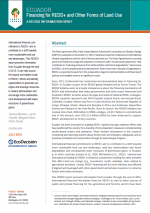Ecuador: Financing for REDD+ and Other Forms of Land Use
A REDDX Information Brief
View PublicationThe Paris Agreement (PA) of the United Nations Framework Convention on Climate Change (UNFCCC), adopted on December 12, 2015, marked an important milestone in international climate negotiations and the role of forests and land use. The Paris Agreement is a turning point to formally encourage the adoption of measures with “results-based payments” that contribute to “reducing emissions from deforestation and forest degradation,” also known as REDD+, at the jurisdictional and national level. After more than a decade of negotiations, REDD+ is expected to pass from the preparation stage to implementation and financing of policies and tangible actions at significant scales.
Since 2012, EcoDecisión has researched and disseminated data on financing for REDD+ in Ecuador as part of the REDDX global initiative led by Forest Trends. The REDDX initiative aims to provide transparency about the financing mechanisms of REDD+ and information that helps governments and other actors interested and involved in REDD+ to better assess the gaps and needs of national REDD+ strategies. REDDX countries represent over 65% of global tropical forests and include Brazil, Colombia, Ecuador, Mexico and Peru in Latin America; the Democratic Republic of Congo, Ethiopia, Ghana, Liberia and Tanzania in Africa; and Indonesia, Papua New Guinea and Vietnam in the Asia-Pacific. Since its launch, the REDDX initiative has tracked more than US$6 billion in REDD+ pledges, US $3.7 billion in commitments and of this amount, over USD $2.3 billion (60%) has been disbursed to support REDD+ development in 13 key countries.

